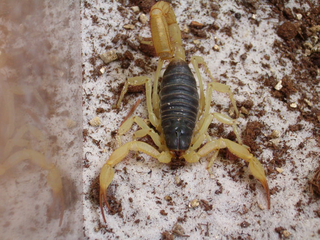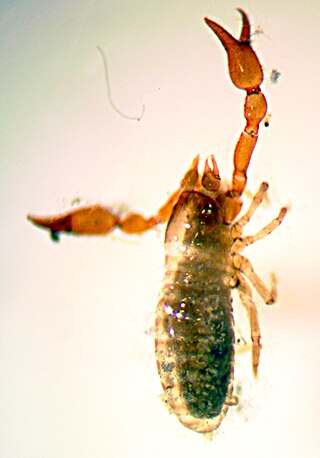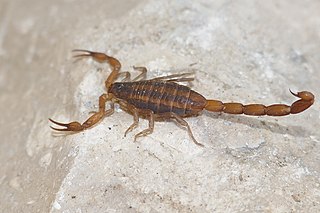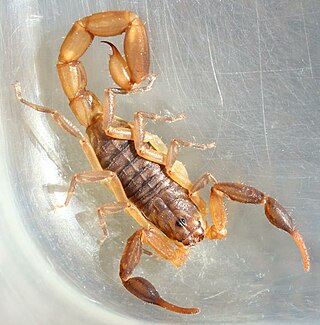
Gallieniellidae is a family of spiders first described by J. Millot in 1947. It was originally thought to be endemic to Madagascar until species were also found in southern Kenya, northeastern Argentina, and Australia. Drassodella was transferred from the family Gnaphosidae in 1990. They are suspected to be specialized in ant-preying.
Hadogenes bicolor is a species of scorpion endemic to South Africa. This species is often confused with H. troglodytes.

Hadogenes troglodytes is a species of scorpion from southern Africa. It is commonly known as the flat rock scorpion and commonly sold on the exotic pet market. It was once regarded as having the longest recorded body length of any scorpion, reaching up to 20 cm; however Heterometrus swammerdami currently holds the record for being the world's largest scorpion at 9 inches (23 cm) in length. May be confused with Hadogenes bicolor.
Anaulacodithella is a genus of pseudoscorpions in the family Chthoniidae. It has about seven described species.
Anisoditha is a genus of pseudoscorpions in the family Chthoniidae. There is at least one described species in Anisoditha, A. curvidigitata.
Compsaditha is a genus of pseudoscorpions in the family Chthoniidae. There are about 12 described species in Compsaditha.
Cryptoditha is a genus of pseudoscorpions in the family Chthoniidae. There are at least two described species in Cryptoditha.
Dithella is a genus of pseudoscorpions in the family Chthoniidae. There are at least two described species in Dithella.
Heterolophus is a genus of pseudoscorpions in the family Chthoniidae. There are at least four described species in Heterolophus.
Typhloditha is a genus of pseudoscorpions in the family Chthoniidae. There are at least three described species in Typhloditha.
Verrucaditha is a monotypic genus of pseudoscorpions in the family Chthoniidae. Its sole described species is Verrucaditha spinosa.
Verrucadithella is a genus of pseudoscorpions in the family Chthoniidae. There are at least three described species in Verrucadithella.
Tityus tenuicauda is a species of scorpions in the family Buthidae. This species was believed to be endemic to the island of Trinidad in Trinidad and Tobago. The distribution range of T. tenuicauda has been extended westward until Las Melenas, a location in the western side of Paria Peninsula National Park, Sucre State, northeastern Venezuela.

Hadogenes soutpansbergensis is a scorpion species endemic to South Africa in the bicolor group of the genus Hadogenes. It is named after the Soutpansberg mountain range where it was found.

Hadrurus is a genus of scorpions which belongs to the family Hadruridae. They are found in sandy deserts and other xeric habitats in northwestern Mexico and in southwest United States. They are among the largest of all scorpion genera, only surpassed by Hadogenes, Pandinus, Heterometrus and Hoffmannihadrurus.
Hadogenes gunningi, commonly known as Gunning's rock scorpion or Rotsskerpioene in afrikaans, is a small species of scorpion of the genus Hadogenes. It is found in southern Africa, particularly the province of Gauteng. The venom of the members of the genus Hadogenes has been compared to a nettle sting and will often results in an itch for roughly two minutes.

Microbisium parvulum is a species of pseudoscorpion in the family Neobisiidae.

Centruroides hentzi, the Hentz striped scorpion, is a species of bark scorpion in the family Buthidae. They are native to the southeastern United States including the states of Florida, southwestern Alabama, and in the coastal plain of Southern Georgia including surrounding barrier islands. C. hentzi is present in other states such as North Carolina and South Carolina due to accidental human importations.

Pseudolychas is a genus of scorpion in the family Buthidae. Species of the genus are known as the pygmy-thicktail scorpions and are found in South Africa, Eswatini and Mozambique. Their venom is mild and not medically important.







